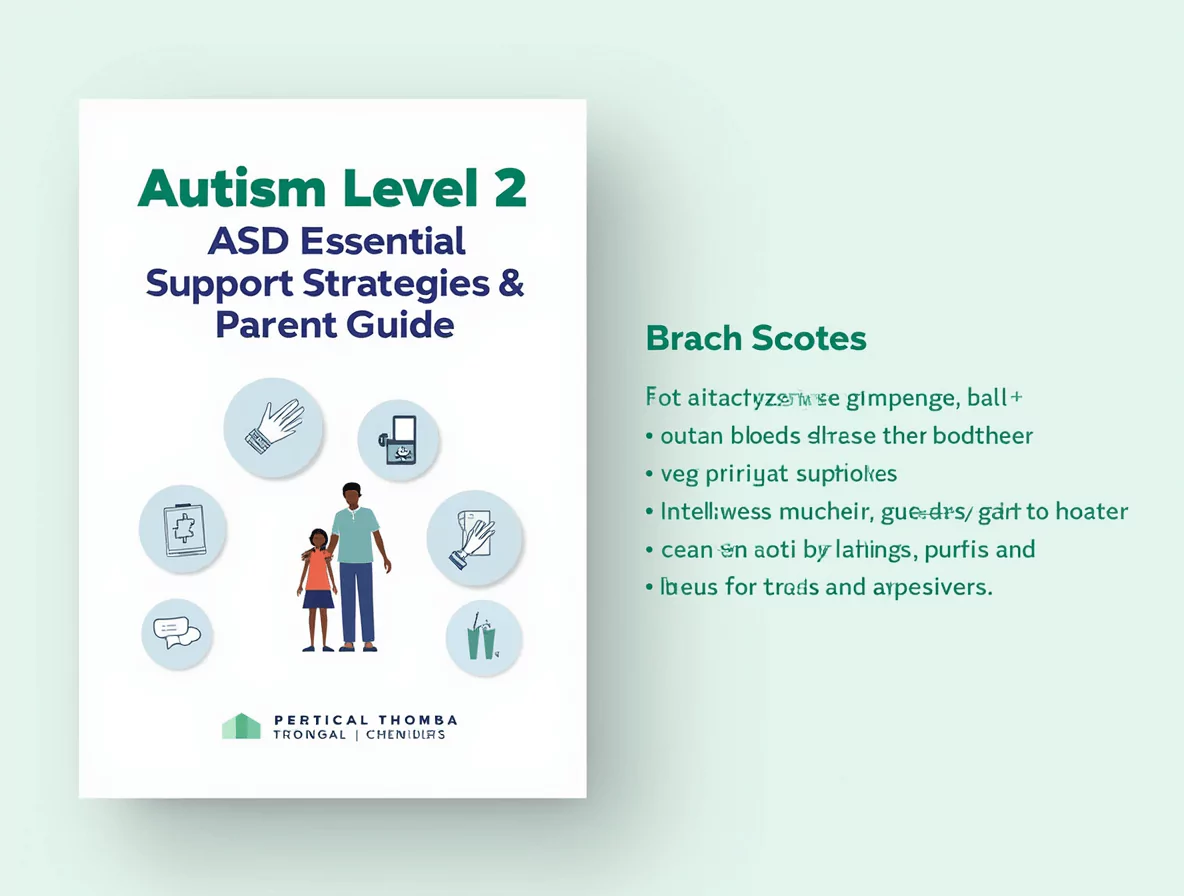With 9 years of experience in the kitchen, I’m passionate about crafting delicious recipes and sharing them with food lovers worldwide. 🍽️✨ Whether it’s a comforting homemade dish or a creative cocktail, my goal is to make cooking fun, easy, and enjoyable for everyone. Join me on this flavorful journey! 🍹🥗

Autism Level 2 ASD: Essential Support Strategies & Parent Guide [2025]
Introduction: Understanding Autism Level 2 ASD and Its Support Needs
Navigating the world of autism spectrum disorder (ASD) can feel overwhelming, especially when your child receives a diagnosis of autism level 2. This diagnosis indicates that your child requires substantial support to manage daily activities, social interactions, and communication. This guide serves as a comprehensive resource for parents and caregivers, offering essential support strategies, resources, and actionable advice to help your child thrive. We aim to empower you with the knowledge and tools necessary to advocate for your child’s unique needs and create a nurturing environment that fosters their growth and development.
Table of Contents
- Introduction: Understanding Autism Level 2 ASD and Its Support Needs
- Understanding Autism Level 2 ASD: Core Characteristics
- Addressing Communication Challenges in Autism Level 2 ASD
- Navigating Social Interaction Difficulties in Autism Level 2 ASD
- Managing Repetitive Behaviors and Sensory Sensitivities
- Effective Therapy Options for Autism Level 2 ASD
- Applied Behavior Analysis (ABA) Therapy
- Speech and Language Therapy
- Occupational Therapy
- Social Skills Training
- Creating a Supportive Home and School Environment
- Home Modifications for Sensory Sensitivities
- Implementing Visual Supports and Schedules
- Collaboration with School Professionals
- Setting Realistic IEP Goals for Autism Level 2 ASD
- Essential Resources and Support Networks for Parents
- Local Autism Organizations
- Online Autism Communities
- Financial Assistance Programs
- Prioritizing Self-Care as a Caregiver
- Managing Stress and Preventing Burnout
- Seeking Support from Therapists and Counselors
- Preparing for Transition to Adulthood with Autism Level 2 ASD
- Vocational Training and Employment Opportunities
- Developing Independent Living Skills
- Legal and Financial Considerations
- Conclusion: Empowering Your Child with Autism Level 2 ASD to Thrive
- Frequently Asked Questions (FAQs)
Understanding Autism Level 2 ASD: Core Characteristics
Autism spectrum disorder is a neurodevelopmental condition characterized by challenges in social communication, interaction, and the presence of restricted, repetitive behaviors or interests. Level 2 ASD, as defined by the Diagnostic and Statistical Manual of Mental Disorders (DSM-5), indicates a need for substantial support. Individuals with autism level 2 often experience significant difficulties in both verbal and nonverbal communication, limiting their ability to initiate or respond to social interactions. They may also exhibit more pronounced repetitive behaviors or have difficulty coping with changes in routines. Understanding these core characteristics is crucial for developing effective intervention strategies and providing appropriate support. You can also visit our about page to learn more about our mission.
Addressing Communication Challenges in Autism Level 2 ASD
Communication is a fundamental aspect of human interaction, and individuals with autism level 2 often face significant communication challenges. These challenges can manifest in various ways, including limited spoken language, difficulty understanding social cues, and struggles with initiating or maintaining conversations. Some individuals may rely on alternative communication methods, such as picture exchange systems (PECS) or assistive technology, to express their needs and ideas. Early intervention and targeted speech therapy can play a crucial role in improving communication skills and fostering meaningful connections.
Managing Repetitive Behaviors and Sensory Sensitivities
Repetitive behaviors and sensory sensitivities are common characteristics of autism level 2. Repetitive behaviors can include hand-flapping, rocking, or fixated interests. Sensory sensitivities can involve heightened or reduced sensitivity to sounds, lights, textures, or tastes. Understanding these sensitivities and providing appropriate accommodations can significantly improve comfort and reduce anxiety. Strategies such as creating a sensory-friendly environment, providing fidget toys, or implementing calming routines can help manage these challenges. For more information, you can refer to the Autism Speaks website: Autism Speaks.
Effective Therapy Options for Autism Level 2 ASD
A variety of therapies can be beneficial for individuals with autism level 2. The specific therapies recommended will depend on the individual’s needs and goals. Common therapy options include applied behavior analysis (ABA) therapy, speech and language therapy, occupational therapy, and social skills training. A multidisciplinary approach, involving collaboration between therapists, educators, and parents, is often the most effective way to address the diverse needs of individuals with autism level 2.
Applied Behavior Analysis (ABA) Therapy
Applied Behavior Analysis (ABA) is a widely recognized and evidence-based therapy for autism. It focuses on understanding and changing behavior through the application of learning principles. ABA therapy for autism level 2 often involves intensive, individualized interventions designed to improve communication, social skills, and adaptive behaviors. ABA therapists work closely with families to develop and implement behavior plans that address specific needs and goals.
Speech and Language Therapy
Speech and language therapy is essential for addressing communication challenges in autism level 2. Speech therapists can help individuals improve their expressive and receptive language skills, as well as their ability to communicate effectively in social situations. Therapy may focus on improving articulation, expanding vocabulary, understanding grammar, and developing social communication skills. Augmentative and alternative communication (AAC) methods may also be introduced to support communication.
Occupational Therapy
Occupational therapy (OT) focuses on improving daily living skills and sensory processing abilities. Occupational therapists work with individuals with autism level 2 to develop skills needed for self-care, such as dressing, eating, and hygiene. They also address sensory sensitivities and help individuals develop strategies for managing sensory input. OT can also help improve fine motor skills, gross motor skills, and coordination. Visit our services page to learn more.
Creating a Supportive Home and School Environment
Creating a supportive home and school environment is crucial for the well-being and development of individuals with autism level 2. A supportive environment is one that is predictable, structured, and responsive to the individual’s needs. It also involves providing opportunities for learning, growth, and social interaction.
Home Modifications for Sensory Sensitivities
Modifying the home environment to accommodate sensory sensitivities can significantly improve comfort and reduce anxiety. This may involve reducing clutter, minimizing noise, and providing calming spaces. Using soft lighting, neutral colors, and natural materials can create a more sensory-friendly environment. Providing designated quiet areas where the individual can retreat when feeling overwhelmed is also beneficial.
Implementing Visual Supports and Schedules
Visual supports and schedules can provide predictability and structure for individuals with autism level 2. Visual schedules can help individuals understand the sequence of activities throughout the day and reduce anxiety associated with transitions. Visual supports can also be used to communicate expectations, teach new skills, and provide reminders. Examples of visual supports include picture cards, social stories, and visual timers.
Collaboration with School Professionals
Collaboration between parents and school professionals is essential for ensuring that individuals with autism level 2 receive appropriate support and accommodations in the school setting. Regular communication, shared goal-setting, and active participation in IEP meetings are crucial. Parents can provide valuable insights into their child’s strengths, needs, and preferences, while school professionals can offer expertise in educational strategies and accommodations.
Setting Realistic IEP Goals for Autism Level 2 ASD
The Individualized Education Program (IEP) is a legal document that outlines the educational goals and services for students with disabilities. Setting realistic and measurable IEP goals is crucial for tracking progress and ensuring that the student receives appropriate support. IEP goals should be based on the student’s individual needs and strengths and should address areas such as communication, social skills, academics, and adaptive behavior. It is important to involve the student in the IEP process as much as possible.
Essential Resources and Support Networks for Parents
Parenting a child with autism level 2 can be challenging, and it is essential to have access to reliable resources and support networks. These resources can provide information, guidance, and emotional support. Connecting with other parents who have similar experiences can be particularly helpful.
Local Autism Organizations
Local autism organizations can provide a range of services, including support groups, workshops, and recreational activities. These organizations can also connect families with local resources and professionals. Contacting your local chapter of Autism Speaks or the Autism Society of America is a good starting point.
Online Autism Communities
Online autism communities provide a virtual space for parents to connect, share experiences, and ask questions. These communities can be a valuable source of information and emotional support. Popular online communities include Facebook groups, online forums, and websites dedicated to autism.
Financial Assistance Programs
Raising a child with autism level 2 can be expensive, and many families may be eligible for financial assistance programs. These programs can help cover the costs of therapy, medical care, and other expenses. Examples of financial assistance programs include Medicaid, Supplemental Security Income (SSI), and state-funded disability programs. More information about government assistance programs can be found on USA.gov.
Prioritizing Self-Care as a Caregiver
Caring for a child with autism level 2 can be demanding, and it is essential for caregivers to prioritize self-care. Self-care involves taking steps to protect your physical, emotional, and mental well-being. Neglecting self-care can lead to burnout and negatively impact your ability to care for your child.
Managing Stress and Preventing Burnout
Managing stress is crucial for preventing burnout. Strategies for managing stress include getting enough sleep, eating a healthy diet, exercising regularly, and practicing relaxation techniques. It is also important to set realistic expectations, ask for help when needed, and take breaks throughout the day.
Seeking Support from Therapists and Counselors
Seeking support from therapists and counselors can provide a safe space to process emotions, develop coping strategies, and address mental health concerns. Therapists can help caregivers manage stress, anxiety, and depression. They can also provide guidance on parenting strategies and communication techniques. Seeking professional help is a sign of strength, not weakness.
Preparing for Transition to Adulthood with Autism Level 2 ASD
Preparing for the transition to adulthood is a critical step for individuals with autism level 2 and their families. This transition involves planning for independent living, vocational training, employment, and social integration. Early planning and preparation are essential for ensuring a successful transition.
Vocational Training and Employment Opportunities
Vocational training can help individuals with autism level 2 develop skills needed for employment. Training programs may focus on specific job skills or on general work readiness skills. Employment opportunities for individuals with autism are increasing, and many companies are actively seeking to hire individuals with diverse abilities. Supported employment programs can provide assistance with job placement, training, and ongoing support.
Developing Independent Living Skills
Developing independent living skills is crucial for individuals with autism level 2 to live as independently as possible. These skills include self-care, household management, financial management, and transportation. Teaching independent living skills requires patience, repetition, and individualized instruction. Breaking down tasks into smaller steps and providing visual supports can be helpful.
Legal and Financial Considerations
Navigating the legal and financial aspects of supporting an individual with autism level 2 can be complex. It is important to understand the legal rights and protections available to individuals with disabilities. Estate planning, special needs trusts, and guardianship are important considerations for ensuring the long-term financial security and well-being of individuals with autism. Consulting with an attorney or financial advisor specializing in special needs planning is recommended.
Conclusion: Empowering Your Child with Autism Level 2 ASD to Thrive
Supporting a child with autism level 2 requires understanding, patience, and a commitment to providing individualized support. By implementing effective therapies, creating a supportive environment, and accessing available resources, you can empower your child to thrive and reach their full potential. Remember that every child is unique, and the journey may have its challenges, but with the right support and resources, your child can lead a fulfilling and meaningful life.





Navigating Social Interaction Difficulties in Autism Level 2 ASD
Social interaction can be particularly challenging for individuals with autism level 2. They may struggle to understand social norms, interpret nonverbal cues, and engage in reciprocal interactions. Difficulties in forming and maintaining relationships are also common. Social skills training, often provided in a structured setting, can help individuals learn and practice social skills, such as initiating conversations, taking turns, and understanding emotions. Creating opportunities for structured social interactions, such as playdates or group activities, can also provide valuable learning experiences. Don’t hesitate to contact us for more support!